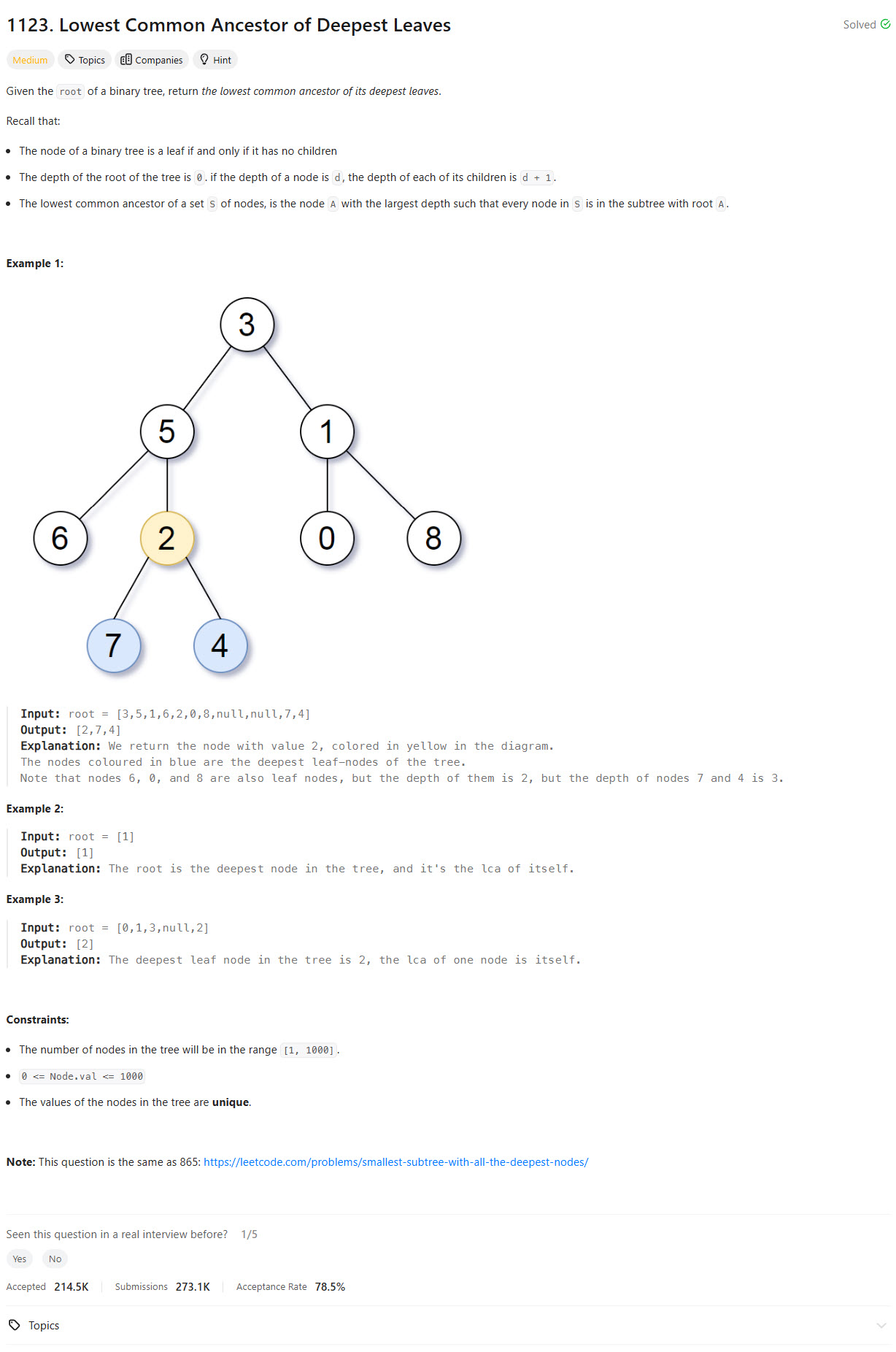Problem of The Day: Lowest Common Ancestor of Deepest Leaves
Problem Statement

Intuition
To find the Lowest Common Ancestor (LCA) of the deepest leaves in a binary tree, we need to:
- Determine how deep the deepest leaves go.
- Collect all leaves at that deepest level.
- Find the lowest node in the tree that is an ancestor to all of those deepest leaves.
Approach
-
Calculate the maximum depth of the tree using a recursive function
find_depth.- This function returns the depth of the deepest subtree by recursively exploring left and right branches.
-
Collect all deepest leaves using
find_deepest_leaves.- Traverse the tree while tracking the current level.
- When the current level matches the maximum depth, add the node to a list of deepest leaves.
-
Find the LCA of the deepest leaves:
- If there is only one deepest leaf, it is its own ancestor — return it.
- Otherwise, use a recursive
lcafunction that checks whether each subtree contains one of the target leaves. - When two of the three flags (
left,right,mid) are True, the current node is the LCA. - Save the LCA in
self.lca_node.
Complexity
-
Time complexity:
\(O(n)\)
Each of the three main functions (find_depth,find_deepest_leaves, andlca) traverses the tree once. -
Space complexity:
\(O(h)\)
Where ( h ) is the height of the tree due to recursive stack space.
Code
# Definition for a binary tree node.
# class TreeNode:
# def __init__(self, val=0, left=None, right=None):
# self.val = val
# self.left = left
# self.right = right
class Solution:
def lcaDeepestLeaves(self, root: Optional[TreeNode]) -> Optional[TreeNode]:
res = []
depth = [0]
def find_depth(node):
if not node:
return -1
left = find_depth(node.left) + 1
right = find_depth(node.right) + 1
return max(left, right)
def find_deepest_leaves(node, last_level, curr_level, leaves):
if not node:
return
if curr_level == last_level:
leaves.append(node)
return
find_deepest_leaves(node.left, last_level, curr_level + 1, leaves)
find_deepest_leaves(node.right, last_level, curr_level + 1, leaves)
def lca(node, p, q):
if not node:
return False
left = lca(node.left, p, q)
right = lca(node.right, p, q)
mid = node is p or node is q
if sum([left, right, mid]) >= 2:
self.lca_node = node
return left or right or mid
deepest_level = find_depth(root)
leaves = []
find_deepest_leaves(root, deepest_level, 0, leaves)
if len(leaves) == 1:
return leaves[0]
self.lca_node = root
lca(root, leaves[0], leaves[-1])
return self.lca_node
Editorial
Approach 1: Recursion
class Solution:
def lcaDeepestLeaves(self, root: Optional[TreeNode]) -> Optional[TreeNode]:
def dfs(root):
if not root:
return 0, None
left = dfs(root.left)
right = dfs(root.right)
if left[0] > right[0]:
return left[0] + 1, left[1]
if left[0] < right[0]:
return right[0] + 1, right[1]
return left[0] + 1, root
return dfs(root)[1]